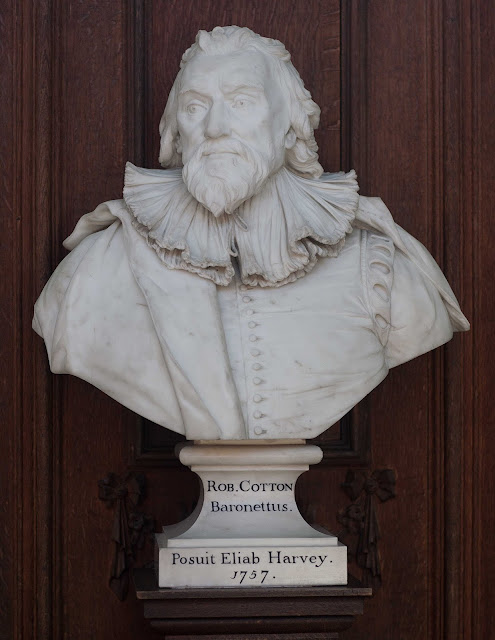The Marble Bust of Sir Robert Bruce Cotton (1571 - 1631).
Founder of the Cotton Library.
Bust in the Wren Library,
Trinity College, Cambridge.
Louis Francois Roubiliac.
Commissioned by Eliab Harvey and finished in 1757.
Sir
Robert Bruce Cotton was educated at Westminster School and Jesus College,
Cambridge. By 1588 or perhaps even earlier he had started collecting. In its
final form his collection included manuscripts, maps, charters, rolls, printed
books, inscriptions, stones (such as Roman monuments from the north of
England), medals, coins, seals and curiosities. In 1622 he settled in Cotton
House, Westminster.
His library was open to scholars including Francis Bacon,
William Camden, Sir Walter Raleigh, Seiden and others. On the foundation of the
Bodleian Library in 1601, he sent a gift of manuscripts.
He was knighted by
James I in 1603; the following year he was elected MP for Huntingdon, and was
created baronet in 1611. He subsequently sat for Old Sarum in 1624, Thetford in
1625 and Castle Rising in 1628-9. In 1615-16 he was imprisoned for trying to
shield the Earl of Somerset. In the 1620s he attached himself to the
Parliamentary party and published political tracts. He was excluded by order of
King Charles I from his library in 1629-31. Some of Cotton's papers were
printed posthumously.
This text lifted from the British Museum website (see below for the terracotta bust.
___________________________________
Sir Robert Cotton had organised his library according to the case, shelf and position of a book within a room twenty-six feet long and six feet wide. Each of the fourteen bookcase in his library was topped by busts of classical personages, including Augustus Caesar, Caligula, Claudius, Cleopatra, Julius Caesar, Domitian, Faustina, Galba, Nero, Otho, Tiberius, Titus, Vespasian, Vitellius.
In total, he had fourteen busts, and his scheme worked by Bust-Shelf - letter-Volume number from end.
Thus, the two most famous of the manuscripts from the Cotton library are "Cotton Vitellius A.xv" and "Cotton Nero A.x." In Cotton's own day, that meant "Under the bust of Vitellius, top shelf (A), and count fifteen over," for the Liber Monstrorum of the Beowulf manuscript, or "Go to the bust of Nero, top shelf, tenth book" for the manuscript containing all the works of the Pearl Poet.
The manuscripts are still catalogued by these call numbers in the British Library.
This I believe is the first mention of the use of classical busts in an English Library.
All images above copyright the Master and Fellows of Trinity College, Cambridge.
I am very grateful to Sandy Paul, Sub Librarian at Trinity College Library for arranging for me to receive these photographs.
see -
http://www.facebook.com/trin.coll.cam.lib
_______________________________
The Terracotta Bust of Sir Robert Cotton.
The British Museum.
Photographs by the author.
The terracotta was retained by Eliab Harvey, the second son of William and Mary Harvey and retained by the family until acquired by the British Museum in 1924 after previously being offered to the National Portrait Gallery who unfortunately for them were unable to take posthumous busts! It had been advertised in the Connoisseur in May 1922 at the pice of £150.
Roubiliac was responsible for the monument to William and Mary Harvey at the church of St Andrew, Hempstead, Essex erected in 1758.
see British Museum website -
See below for the Harvey family monuments in St Andrews Church, Hempstead, Essex.








Sir Robert Cotton
Terracotta
Height 78 cms
British Museum
Photographs the author.
______________________________

Sir Robert Cotton
engraving by T. Cross after Cornelius Jansens
135 x 91 mm
1655
National Portrait Gallery
________________________

Sir Robert Cotton
engraving
Robert White
300 x 188 mm
1696
National Portrait Gallery
________________________________

Sir Robert Cotton
Engraving - BM say after Cornelius Janssen formerly believed to be by Paul van Somer
from Vetusta Monumenta - pub. The Society of Antiquaries
The original with the Society of Antiquaries
George Vertue
504 x 356 mm.
1747
Nation Portrait Gallery
_________________________________

Sir Robert Cotton
Portrait Attrib. Cornelius Jansens
(Cornelis Janssens van Ceulen, 1593 - 1661)
56 x 43 cms
1629
Trinity College, Cambridge


Sir Robert Cotton
attrib. Cornelius Jansens
(Cornelis Janssens van Ceulen, 1593 - 1661)
1629
British Museum
________________________________

Sir Robert Cotton
Internet image from a so far unidentified source.
Engraved by George Vertue (see above).
Cornelius Janssen.
________________________________
The Harvey Family Monuments Hempstead, Essex.

Monument to William Harvey
Edward Marshall.

The bust of William Harvey
Edward Harvey
_________________________________

Page from the Graphic magazine

Monument to William and Mary Harvey by Louis Francois Roubiliac.



No comments:
Post a Comment